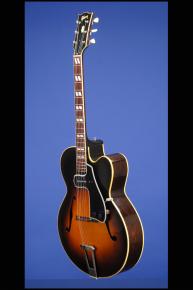Gibson's Most Successful 17-Inch Archtop
Essentially a Plain Version of the L-5
This sixty year old L-7CE 'McCarty' weighs just 5.70 lbs. and has a nut width of 1 11/16 inches and a scale length of 25 1/2 inches. Seventeen inch wide, 3 1/3 inches deep body with hand-carved book-matched solid spruce top, two-piece solid maple back, solid maple sides and two unbound 'f' holes. Two-piece maple neck with mahogany center-strip. Brazilian rosewood fretboard with 20 original thin frets and inlaid pearl double-parallelogram position markers. The body is triple-bound, the fretboard and headstock are single-bound. Headstock with inlaid pearl "Gibson" logo and pearl crown inlay. Single-layer blacl plastic truss-rod cover with two screws. Black laminate widow's peak on the back of the headstock. Individual 'no-name' Kluson Deluxe tuners with single-ring Keystone plastic buttons (stamped on the underside "2356766 / Pat Appld.") Original Gibson 'McCarty' single-coil pickup with non-adjustable, flat pole pieces mounted into a five layer black over white plastic laminated pickguard together with one volume and one tone control and a screw-on type input jack. Black plastic circular knobs (5/8 inch in diameter, 5/16 inches tall) with ribbed sides. Frequensated rosewood bridge on rosewood base and standard trapeze tailpiece with three raised parallelograms on cross-bar. Original oval white label inside the bass f-hole with the Style "L7-C" written in black ink and the serial number "A-9135" stamped in black. This guitar is in mint (9.50) condition with just some very light finish checking and the tiniest amount of fret wear on the first couple of frets. Quite simply - this is most probably the finest example of an all original L-7 CE MacCarty on the planet… Complete with an original 'Proll' Spanish Guitar Tuner in its original box. Housed in the original Gibson 'Faultless' 'four-latch' shaped brown hardshell case with green 'flannel' lining (9.25).
"In 1948 Ted McCarty joined the Gibson company, and one of his first priorities was to expand the potential number of Gibson's electric guitar models in a quick and inexpensive way. He invented an ingenious pickup/pickguard assembly known now as the McCarty pickup, consisting of a very thin single-coil pickup with non-adjustable, flat pole pieces mounted into a laminated pickguard along with volume and tone controls and an input jack. The McCarty pickup assembly was offered in single - and double - pickup versions, for cutaway and non cutaway guitars, and for guitars with nickel-plated parts and gold-plated parts. The pickup was officially introduced on the L-7 guitar as an option, and these early electric L-7s were labeled the L-7E or the L-7PE, with the letter E designating their electric status, while P indicated Premiere, or cutaway, body style. In reality, these were stock L-7 guitars that had the McCarty pickup assembly supplied with them at the factory instead of a conventional acoustic pickguard."
The Gibson "finger rest" pickup (better know as the McCarty Pickup) was originally presented at the June 1948 NAMM Convention as a device to electrify an acoustic archtop guitar without compromising it's acoustic tone. It was initially offered as a standard appointment on the L-7. By the time it was pulled from the gibson catalog in 1971, had been available in many variations (cutaway/non-cutaway, single/double, gold/nickel hardware). It was essentially a pickguard with a built-in Gibson pickup, similar to a P-90 but thinner, (or two) that would allow owners of acoustic archtop guitars to amplify their instrument.
Pickup manufacturer, Jason Lollar, said, "Mccartys use rod magnets 3/8" long but they use a dog ear baseplate so if you looked at the bottom of one you could mistake it for a P-90. They sound pretty impressive - a little less mids than a typical P-90 but still fat. You can get a good clear powerful cutting tone or roll back some tone and get a nice round jazz tone without getting too muddy." Jason is the only pickup maker I'm aware of that has made McCarty-style pickups for archtop guitar.
The McCarty Pickup, named after Ted McCarty, who, after joining Gibson in 1948 and becoming vice president and general manager just one year later, contributed to it's development).
Originally introduced in 1948 as a 'plain' version of the L-5. "Extremely popular for orchestra use, the L-7C with its modern cutaway design has outstanding appearance and an unusually rich tone. Gibson quality, exclusive features, and expert workmanship insure perfection in every detail of construction. Attractive alternate white-black-white ivoroid binding - hand graduated carved top of selected spruce, arched curly maple back with matching curly maple rims. Three piece curly maple neck, with adjustable Truss Rod construction - bound rosewood fingerboard with attractive parallel pearl inlay design. Nickel-plated metal parts, Gibson designed tailpiece, laminated pickguard with attractive border, rosewood adjustable bridge, and enclosed individual machine heads with deluxe buttons." (1957-8 Gibson catalog).
"With the L-7 a player could buy a guitar that was almost as good as an L-5 but at no more than half the price. The earliest L-7s have fingerboard inlay appropriated from the Nick Lucas flat top, which, ironically, was the top model of the flat top line" (George Gruhn and Walter Carter, Acoustic Guitars and Other Fretted Instruments: A Photographic History, p. 172).
Translate:









